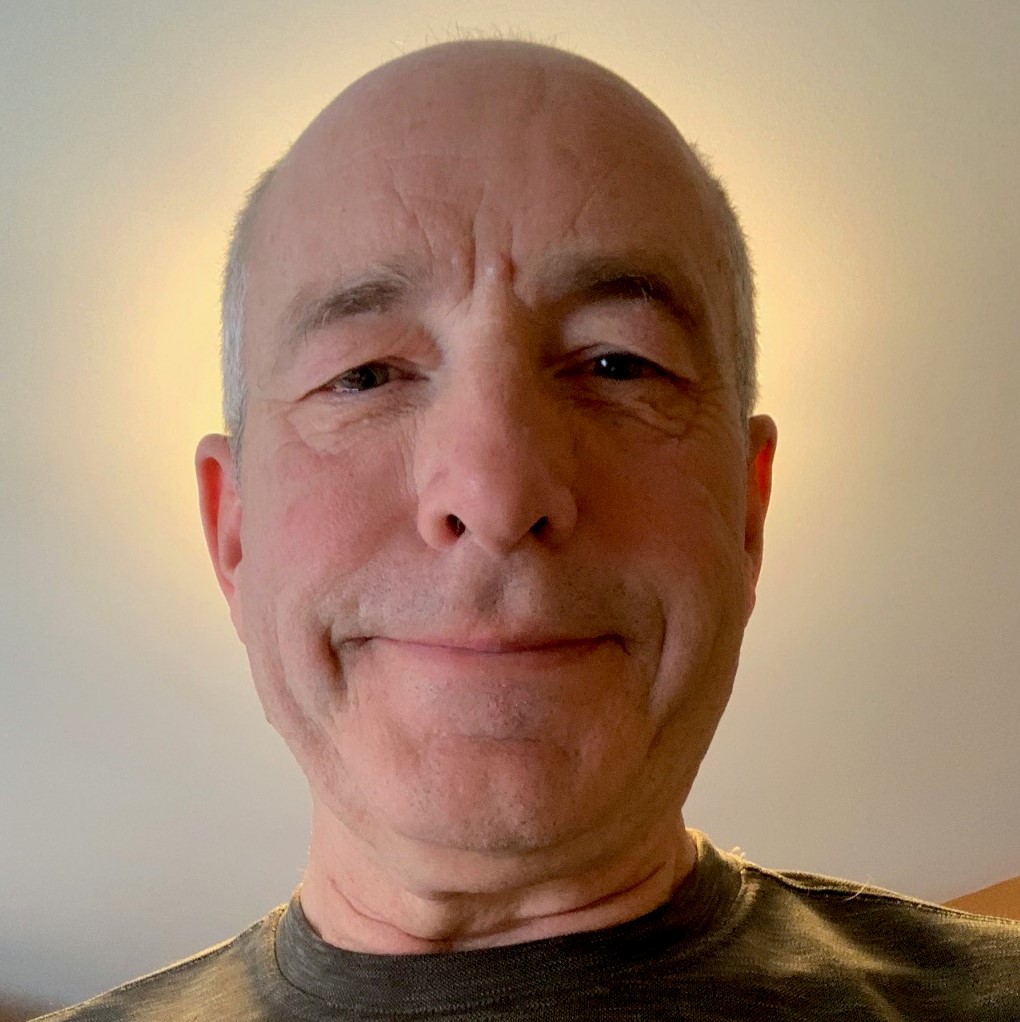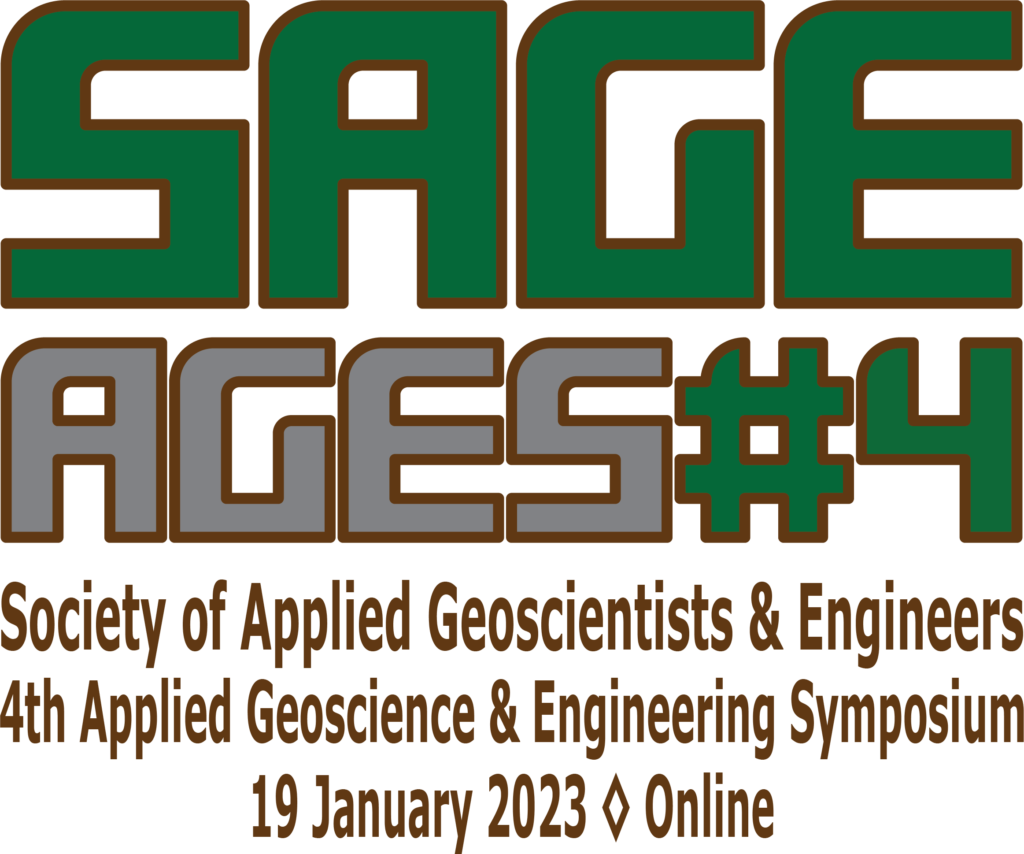4th SAGE Applied Geoscience and Engineering Symposium (SAGE AGES #4), 19 January 2023, Online
"Image Logging Technology and Applications"
SAGE AGES #4
SAGE hosted an international Virtual Symposium on “Image Logging Technology and Applications” on 19 January 2023 as part of its Applied Geoscience & Engineering Symposium (SAGE AGES) series.
We were pleased to offer the live event for free to not only SAGE members and the speakers, but also at no charge for non-members, and will be posting soon on-demand content after the event (speakers permitting).
See below for speaker listing and abstracts of presentations. Hyperlinks are provided for individual documentation (publication, video, and or/slides) of each presentation as part of the SAGE Record, our record of event proceedings.
Schedule of Presentations
| US Central Standard Time (GMT-6) | Speakers | Title | Hyperlink |
|---|---|---|---|
| 8:50-9:00 AM | James J. Willis (SAGE President and SAGE AGES #4 Convenor) | SAGE AGES #4 on “Image Logging Technology and Applications”—Welcome and Introduction | http://sagetech.org/sage_record_113_willis/ |
| 9:00-9:25 AM | Andrew Wilson (Image Strat Pty Ltd, West Perth, Western Australia, Australia), Alexander Côté, Brenton Richards, and Carl Altmann (Tamboran Resources, Brisbane, Queensland, Australia) | Borehole Image Features Map Depositional Environment Change in Mesoproterozoic Deltas: Insights from the Beetaloo Sub-Basin, Northern Territory, Australia | http://sagetech.org/sage_record_117_wilson_et_al/ |
| 9:30-9:50 AM | James J. Willis (Applied-Geoscience, LLC, St. Martinville, LA; Louisiana State University, Baton Rouge, LA) and Lauren A. Martz (McKinsey & Co., Houston, Texas) | Relative Strike (RSTRIKE) Curve Extraction from Azimuthal Log Data for Enhanced Petrophysical Refinement | http://sagetech.org/sage_record_116_willis_and_martz/ |
| 10:00-10:50 AM | Kirk Harris (ThoroughBond, LLC, Dammam, Saudi Arabia) | KEYNOTE PRESENTATION: The Value of Cased-Hole Ultrasonic Imaging Logs for Cement Evaluation | http://sagetech.org/sage_record_115_harris/ |
| 11:00-11:50 AM | Howard Brekke (Consultant, Calgary, Alberta, Canada), James A. MacEachern (Applied Research in Ichnology and Sedimentology Group, Department of Earth Sciences, Simon Fraser University, Burnaby, British Columbia, Canada), Tania Roenitz (Consultant, Calgary, Alberta, Canada), and Shahin E. Dashtgard (Applied Research in Ichnology and Sedimentology Group, Department of Earth Sciences, Simon Fraser University, Burnaby, British Columbia, Canada) | KEYNOTE PRESENTATION: The Use of Microresistivity Image Logs to Map Point Bars in the Subsurface: An Example from the McMurray Formation, Canada | http://sagetech.org/sage_record_114_brekke_et_al/ |
Speaker Listing and Abstracts
KEYNOTE PRESENTATION: The Use of Microresistivity Image Logs to Map Point Bars in the Subsurface: An Example from the McMurray Formation, Canada
Howard Brekke (Consultant, Calgary, Alberta, Canada), James A. MacEachern (Applied Research in Ichnology and Sedimentology Group, Department of Earth Sciences, Simon Fraser University, Burnaby, British Columbia, Canada), Tania Roenitz (Consultant, Calgary, Alberta, Canada), and Shahin E. Dashtgard (Applied Research in Ichnology and Sedimentology Group, Department of Earth Sciences, Simon Fraser University, Burnaby, British Columbia, Canada)

Well logs such as spontaneous potential and gamma ray historically have been the only tools available for facies evaluation of uncored wells, and are largely restricted to providing interpretations of lithology. The addition of microresistivity image logs has greatly improved facies identifications and their interpretations, on par with and (in some ways) superior to core-derived facies evaluations. In the case of channel complexes, core descriptions provide details about bedding contacts, sedimentary texture, stratification style, bioturbation intensity, and trace fossil diversity. Image logs provide texture, fabric, bedding contact style, dip directions and angles, large-scale stratification, and bedding architecture information yielding paleoflow and lateral accretion directions. When core description data are integrated with image log analysis, the subsurface analyst possesses a powerful tool for characterizing and mapping facies, facies successions, and facies associations.
Facies identifications associated with channel systems and their associated point bar deposits are based on several image log criteria. Mud-clast breccias display variable dip angles and dip directions. Cross-stratified sands comprise vertical successions of stacked, internally consistent bedsets with high dip angles (>15°) that indicate paleoflow direction. Lateral accretion beds show consistent dip directions with a progressive change from shallow-to-steep-to-shallow dip angles (e.g., <4°–15°–<4°) from the base to the top of the succession, associated with beds that dip toward the thalweg of the paleochannel. Flat-lying (<4°) mud-dominated intervals record vertical accretion associated with point bar tops or channel abandonment.
Point bar deposits, although readily recognizable in most successions, are notoriously challenging to map and correlate accurately in the subsurface. Sedimentologic interpretations from microresistivity image logs, by contrast, offer an unparalleled method of accurately reconstructing the point bar architectural elements and mapping their distribution. Bedding dip profiles of architectural elements recording downstream migration, lateral-accretion, and channel abandonment can be reliably demonstrated to record semi-continuous point bar accretion of single or erosionally juxtaposed large-scale channel geobodies. Microresistivity image log analysis clearly demonstrates that bedding arrangements and architectural elements of these heterolithic point bars display discrete and predictable changes in dip angle and direction that are independent of autogenic variations in lithology. We advocate, therefore, that this approach be used to map the facies of point bars in order to reliably predict their reservoir trends.
KEYNOTE PRESENTATION: The Value of Cased-Hole Ultrasonic Imaging Logs for Cement Evaluation
Kirk Harris (ThoroughBond, LLC, Dammam, Saudi Arabia)

Cement bond logs remain a key diagnostic for evaluating annular zonal isolation and overall wellbore integrity. The interpretation of cement evaluation logs also remains a rather subjective discipline, often with debatable conclusions. However, advancements in the past two decades in the area of ultrasonic imaging have provided more clarity and definition, and have aided well integrity professionals in achieving more accurate interpretations.
This presentation outlines the practical value that ultrasonic imaging logs have given to the industry. The top advantages that are presented through field examples include (1) identifying low-density/low strength cements, (2) better discovery of channels in the cement sheath, (3) a stronger understanding of casing centralization, (4) recognition of annular gas sources and paths in the annulus, and (5) more detail in regards to the wellbore condition.
In turn, a clearer picture of the constructed well not only helps us to predict zonal isolation, it then becomes the blue print for how to fix or abandon the wellbore, and just as importantly, how to change the cementing plan to improve the well construction in the future.
BIOGRAPHY: Kirk Harris is the technical advisor for ThoroughBond LLC, which provides technical support for cementing and bond logging challenges. Based in Dammam, Saudi Arabia, Kirk also currently serves as a senior cementing advisor for TAQA Well Services. He has a total of forty-one years of cementing experience in more than thirty countries.
Kirk began his career with Halliburton, where he worked as a cementer, field and research engineer, and technical manager. He then served as the global cementing advisor for Occidental Petroleum, Talisman Energy, and Repsol. Kirk graduated from Purdue University with a bachelor’s degree in civil engineering.
Email: kngharris@thoroughbond.com Tel: +966 59 787 6736
Relative Strike (RSTRIKE) Curve Extraction from Azimuthal Log Data for Enhanced Petrophysical Refinement
James J. Willis (Applied-Geoscience, LLC, St. Martinville, LA; Louisiana State University, Baton Rouge, LA) and Lauren A. Martz (McKinsey & Co., Houston, Texas)


Relative dip (RDIP) is a critical and widely used parameter in structural characterization and geosteering using image log data and represents the maximum tilt of planar element (e.g., bed, fracture, fault) relative to a wellbore, with relative dip azimuth (RAZIM) being its azimuthal direction as measured clockwise from wellbore high side. Relative strike (RSTRIKE), much like normal strike and dip, is perpendicular to the RAZIM direction and represents the orientation at which the planar element appears horizontal relative to the borehole.
During LWD azimuthal log acquisition, data are acquired as the toolface rotates and are partitioned into sectors around the borehole. For example, a 16 sector dataset has 16 individual log curves, each representing a 22.5 degree section around the borehole. Most commonly, the sector log curves are then processed into the classic image log format, for dip and structural characterization, sedimentological/stratigraphic analysis, and so forth. RSTRIKE analysis, however, represents an additional class of azimuthal log analysis, specifically as a means to extract refined petrophysical data from the azimuthal sectored log curves themselves.
The typical log curve acquired during LWD operations is derived by the average measurement over a specific period of time (time-average period typically seconds) as the toolface rotates arounds the borehole. Relative to a given stratal unit, the majority of azimuthal measurements unfortunately exhibit a “cross-stratal” component, especially with thinner units and as RDIP increases (e.g., running “horizontal”). For example, consider in a typical geosteering configuration, when the toolface is high side, the measurement is essentially looking up into younger strata, and when low side, looking down into older strata. The time-average curve resolution is thus degraded, often severely, because of these cross-stratal aspects. However, the individual log sectors that are oriented closest to the RSTRIKE direction (marked as the inflection points of cosinusoid forms on an image log) have a distinct advantage that their measuring direction (or “look orientation”) is most parallel to the strata. RSTRIKE sector logs exhibit reduced cross-stratal measurement and therefore RSTRIKE logs exhibit significantly better stratal resolution (and thus log resolution) versus the typical LWD log curves.
Borehole Image Features Map Depositional Environment Change in Mesoproterozoic Deltas: Insights from the Beetaloo Sub-Basin, Northern Territory, Australia
Andrew Wilson (Image Strat Pty Ltd, West Perth, Western Australia, Australia), Alexander Côté, Brenton Richards, and Carl Altmann (Tamboran Resources, Brisbane, Queensland, Australia)

The Beetaloo Sub-Basin in the Northern Territory is a Proterozoic basin filled predominantly with siliciclastics rocks, the deeper sections only found in subcrop. The Beetaloo Sub-Basin hosts significant unconventional hydrocarbon resources within three identified shale reservoir intervals of the Mesoproterozoic Velkerri Formation. The origin and mode of preservation of organic carbon in the Velkerri Formation is currently debated. A greater understanding of the sedimentology and structural geology of the host formations is required to constrain plausible causal relationships within these units.
Borehole image logs were used to investigate the structural geology and sedimentology of the Beetaloo Sub-Basin ranging from the Velkerri Formation through to the Kyalla Formation in the following wells: Kyalla 117 N2 1, Beetaloo W 1, Kalala S 1, Amungee NW 1, and Tanumbirini 1. These wells provide control points within the present day basinal axes and the southern margin of the Beetaloo Sub-Basin at an average correlation length of 55 km. In addition to standard sedimentary bed dip picking, image facies assignment, and interpretation of image facies associations, sedimentological features were identified and mapped including small-scale erosional features (gutter casts) and v–shaped resistive features.
Gutter casts are first abundant at the base of the Wyworrie Member of the Velkerri Formation and continue up into the base of the Moroak Sandstone, appearing again in the lower portion of the Kyalla Formation. V–shaped resistive features first appear in the upper part of the Wyworrie Member and continue up into the Moroak Sandstone. Both v–shaped resistive features and gutter casts disappear where the Moroak Formation becomes dominantly arenaceous.
Image facies analysis indicates that the study interval consists of offshore, turbidite fan, offshore/prodelta, lower shoreface/distal delta front, and upper shoreface/proximal delta front palaeodepositional environments. The appearance upsection of gutter casts followed by v–shaped resistive features, interpreted as synaeresis crack fills, is interpreted to indicate the basinward progradation of the deltaic system; in the more distal position/deeper water depths, erosional scours are formed by either storm-rip currents or hyperpycnal bottom-hugging currents that are then filled by sediment transported in these flows. In the more proximal location/shallower water depths, synaeresis crack fills form by the introduction of brackish water into a predominantly saline environment.
Acknowledgments
ImageStrat would like to thank Origin Energy and Tamboran Resources for permission to present this work.


